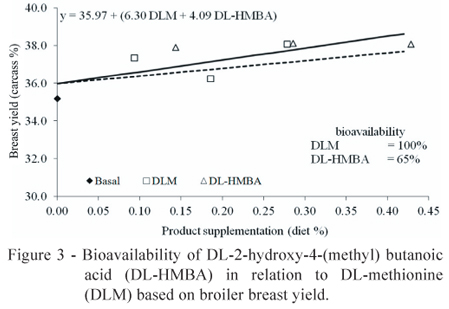The objective of this trial was to evaluate the bioavailability of DL-2-hydroxy-4-(methyl) butanoic acid (DL-HMBA) and a polyherbal ingredient (PHI) in relation to DL-methionine (DLM) on broilers. Nine hundred male broiler chickens of the Cobb 500 strain were fed from 22 to 42 days of age either a basal diet without industrial methionine supplementation or the basal diet supplemented with DL-HMBA at one of three levels (0.143, 0.286 and 0.429%) or DLM at one of three levels (0.093, 0.186 and 0.279%, each of which is 65% of the respective DL-HMBA level by weight) or PHI at one of the same three levels used for DLM (0.093, 0.186 and 0.279%). The weight gain, feed conversion ratio and relative weights of breast and abdominal fat were improved over that of basal diet-fed broilers by the addition of DL-HMBA and DLM to the diet. A simultaneous exponential regression analysis revealed that the relative bioavailability values for DL-HMBA and PHI were 52% and 5% of that of DLM, respectively, for weight gain, and 57% and 4%, respectively, for feed conversion ratio. Concerning breast meat yield, a simultaneous linear regression analysis (slope ratio) showed that the relative bioavailability for DL-HMBA was 65% of that of DLM. Considering all studied parameters together, the relative bioavailability values for DL-HMBA and PHI are 58% and 4.5% of that of DLM on a product basis.
dl-2-hydroxy-4-methylthio butanoic acid; dl-methionine; polyherbal ingredient; sulphur amino acids








